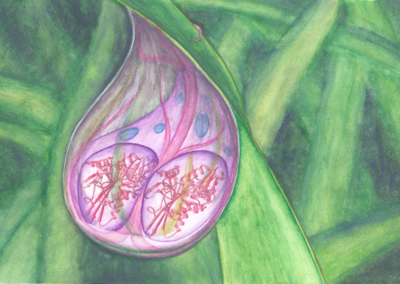Art:Giardia kinesin- a model locomotive
From Proteopedia
Behind the Artwork and the Protein Structure
This image is that of the parasite Giardia, responsible for the water-borne disease giardiasis. It is estimated that up to 30% of the population of the developing world may have giardiasis. This image shows the parasite in a water droplet, with two proteins depicted inside the Giardia double nuclei. The artist who created this image is Anna Valchanova, a student at Stephen Perse School in Cambridge, UK. Her artwork shows two Giardia kinesin proteins inside the nuclei of the parasite, with this symmetry reflected in the symmetry of the two nuclei. The parasite is presented inside a droplet of water to reflect the disease transmission through contaminated water. Giardia has eight tail-like flagella, and these are shown in the image twisting around the vegetation at the water's edge. The protein dipicted is kinesin 2a which is part of the kinesin family, a group of proteins that function as mini motors within cells, in organisms from Giardia to humans. Scientists are using Giardia kinesin as a model system to learn more about this protein family, turning this nasty parasite into a useful tool.
View in 3D or go to PDB structure 2vvg [1]
A Mini Railway System for Cellular Freight
The kinesin family of proteins have many roles in cells. One role is in the assembly and maintenance of flagella in Giardia. The flagella, whip-like appendages which enable the organism to swim, are built of many different proteins, all synthesized in the middle of the cell and then transported out to the distant flagellar tips as the flagellum is assembled. Both flagellar assembly and maintenance is achieved by the movement of protein packages in both directions along the flagellum, on tiny protein tracks called microtubule filaments. The protein depicted in the cell’s nuclei within the artwork is responsible for “driving” these packages along the microtubule filaments, carrying the cargo to its destination.
This family of proteins use the chemical ATP as an energy source. To release the stored energy, ATP is hydrolysed in the 'reaction centre' of the kinesin motor domain, generating ADP as a product. The energy released causes a movement of the protein and generates the power stroke, which causes kinesin to move along the microtubule. This group of proteins have an action which is like 'walking' along the microtubule. The movement cuased by on ATP hydrolysis can be considered a single 'step'. The key to understanding how they work is to obtain snapshots of high resolution structures for the many intermediate states of the ATP hydrolysis reaction. In the figure below the protein is captured in the presence of the product, ADP, bound in the ATP binding pocket.
A Tiny Train Set for Scientists to Study the Family
Giardia kinesin is a useful model system to study this family of proteins, which are intimately linked with many aspects of human health and diseases. Some kinesins are involved in cell division, and malfunction can cause uncontrolled cell proliferation, leading to cancer. While humans do not have flagella, we have analogous structures projecting from some cell types called cilia. These cilia also contain microtubules (and kinesins) and are for moving either the cell itself, or certain substances over the cell surface. The absence or malfunction of cilia in certain diseases, can often be traced to the motor protein, kinesin, as this protein has a key role the human intraflagellar transport complex. Many human pathogens need kinesins in order to enter and exit the host. In addition, functioning kinesins are essential for vision, taste and smell in humans, and vital in embryonic development. Understanding this group of proteins is therefore very important, and Giardia provides an ideal system to study the kinesin family.
Explore the scientific publication
- ↑ Hoeng JC, Dawson SC, House SA, Sagolla MS, Pham JK, Mancuso JJ, Lowe J, Cande WZ. High-resolution crystal structure and in vivo function of a kinesin-2 homologue in Giardia intestinalis. Mol Biol Cell. 2008 Jul;19(7):3124-37. Epub 2008 May 7. PMID:18463165 doi:10.1091/mbc.E07-11-1156

